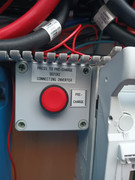Page 1 of 2
Pre charge resistors
Posted: Thu Dec 19, 2024 10:53 pm
by NoraBatty
Apologies if this has been talked to death, but search doesnt throw much up other than Albargey saying he has a pre charge resistor circuit.
https://camelot-forum.co.uk/phpBB3/view ... tor#p44514
I have a 10w 20ohm resistor to use, as recommended by andys OGG.
What are you using if anything?
Car headlight bulbs in series?
An HB pencil? Which some realms of the internet think is okay
Or an actual resistor?
Do you have a circuit for this as Al describes or do you just use freehand as and when.
Re: Pre charge resistors
Posted: Thu Dec 19, 2024 11:47 pm
by Tinbum
I just use a 24v 21w car bulb.
Re: Pre charge resistors
Posted: Fri Dec 20, 2024 7:26 am
by Saladin
Whatever's lying around making sure the auto-start feature on the inverter is disabled.
If it goes up in smoke use a bigger one or a higher impedance.
50 Ohm ±
Lead acid batteries work too.

Re: Pre charge resistors
Posted: Fri Dec 20, 2024 11:30 am
by Stinsy
I like the standard 100W bulb!
Loads of reasons!
- Self fusing, if you fook up and try to put 100A through it, the filament will "ping" harmlessly within the glass.
- Variable resistance. Cold it is about 10Ω but this raises to about 500Ω once it warms up.
- Visual indication of how much current is flowing.
- Cheap.
- Available (well used to be!).
If you want faster then you can parallel up a few 100W 230V bulbs or use a 21W 12V car bulb...
Re: Pre charge resistors
Posted: Fri Dec 20, 2024 3:57 pm
by Ronski
I used to use one of those load resistors you get to put in parallel with LED lights to stop the warning coming on.
I had it hard wired, with a button and a volt meter, I say had because I removed it when I needed the space for another MPPT.
In my setup it's not really required, only time id need it was if the system happened to be turned off during a grid outage, any other time the Quattro pre charges when switched on, then once it's on I'd turn on the batteries.
Re: Pre charge resistors
Posted: Sat Dec 21, 2024 12:37 am
by AlBargey
Yeah, I have a 24V system so used these 25W 15 Ohm resistors:
https://amzn.eu/d/0cQ2cqf
But in general a pre charge resistor for:
12V: 6 ohm(min) -15 ohm, 25W
24V: 15 ohm (min) -30 ohm, 25W
48V: 30 ohm (min) - 60 ohm, 25W
I made a push button pre charge circuit based on really helpful download from DIY Solar, which also shows how to incorporate the resistor into an isolation switch, hope it's ok to post a link to the download over there:
https://diysolarforum.com/resources/inv ... charge.60/

Re: Pre charge resistors
Posted: Sat Dec 21, 2024 11:30 am
by Andy
Stick your voltage and resistor in the website below. So for a 25W resistor, you need about 120ohms. Don't forget the current rating vs the switch you are using as well.
https://www.rapidtables.com/calc/electr ... =#calcform
Re: Pre charge resistors
Posted: Sat Dec 21, 2024 1:09 pm
by AGT
Can I ask what this circuit is for, never heard of it before. Just interested that’s all
Re: Pre charge resistors
Posted: Sat Dec 21, 2024 1:41 pm
by AlBargey
AGT wrote: ↑Sat Dec 21, 2024 1:09 pm
Can I ask what this circuit is for, never heard of it before. Just interested that’s all
"This circuit is designed as an inverter disconnect that allows the user to pre-charge the inverter
capacitors before fully turning on the system."
To stop huge inrush current arcing across cables or shutting down a BMS from the surge when turning a system on after a shutdown or battery disconnect.
Re: Pre charge resistors
Posted: Sat Dec 21, 2024 4:22 pm
by Stinsy
AGT wrote: ↑Sat Dec 21, 2024 1:09 pm
Can I ask what this circuit is for, never heard of it before. Just interested that’s all
Inverters tend to have huge capacitors. When you connect a battery these capacitors draw a huuuuuge current for a very short period as they charge. Unfortionatly pre-packaged battery packs (eg Pylontech) tend to have very fast-acting overcurrent protection. So you can end up in a battle of wills whereby you cannot get the inverter powered because the BMS keeps pulling the plug.
Putting a resistor between the batteries and the inverter temporarily allows the capacitors to charge slower (eg over a second or two) meaning the BMS doesn't throw a wobbly. You can then connect properly without the resistor.
There is a similar problem when adding another string of batteries to an existing pack. You get them as close as possible but these LiFePO4 cells have such a small internal resistance that a small voltage-difference can result in huge current flows. A resistor such as an incandescent bulb or even a helix of wire, slows this down so that instead of 10,000A for 0.1s you get 100A for 10s (or whatever) and a much less dramatic connection process...
